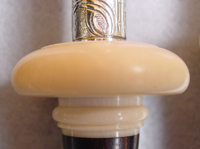Enjoying the pleasures of pipes past
be telling, though not necessarily definitive. The Peter Henderson company maintained very consistent projecting mounts throughout the entire life of the company, and these are usually the prime identifier of a set of vintage Henderson pipes. However, the R. G. Lawrie company made pipes with very similar projecting mounts. In addition, these two companies were contemporary and physically close to each other in Glasgow, and it was common for them to contract work to each other when large orders came in. Turners sometimes moved between the two companies. So while the projecting mounts might point to a drones being Henderson or Lawrie, examination of other parts is needed to determine which. (In truth, the tonal quality of both makes was so high in the early 1900s that a definitive identity hardly matters.)

David Glen projecting mounts were also very distinctive, often utilizing a cut lower bead, sometimes called a ‘parrot’s beak’) on the projecting mount, and ferrules that have no bead and sit flush against the wood. This family of Glens (there was another) operated from the early 1800s to the mid-1900s, and defined the appearance of projecting mounts in the Edinburgh area. So we now talk about pipes being made in the ‘Edinburgh style.’ These were finely turned sticks with cut-bead projecting mounts, and minimally adorned ferrules and drone caps. Many of these could indeed be David Glen, but they might also be John Center or even Duncan MacDougall, who lived in Edinburgh early in his career and adopted elements of the local style. The J & R Glen family also adopted the style. However, the fore-mentioned James Robertson, another Edinburgh maker, maintained his own style that was at the opposite end of the design spectrum from David Glen.
Early makers weren’t too fussy about maintaining a consistent turning style. Duncan MacDougall never seemed to make the same bagpipe twice during the early and mid part of his career. Some of his authentic (stamped) sets also show a remarkable tendency towards irregular thread counts in the combing. Some of his sets are indeed in the Edinburgh style, but others depart radically from this look. It is said that Duncan MacDougall never accepted large military orders and insisted on a personal visit to his shop by anyone ordering a bagpipe. We might surmise from this that he showed pipes and mount sample to prospective clients, suggested styles and made nearly every set to order.
So, it stands that the best means of identifying a bagpipe is to take into account all existing parts of the instrument. This means examining the profiles (shapes) of the various pieces and add-ons, along with a wide range of details and subtle identifying characteristics. Internal bore measurements are also helpful. By adding up the various clues, one can hope to narrow the range of possible makers.
Another challenge in identifying bagpipe makes is the preponderance of small pipemaking companies and amateur makers who may have used the pipes of established companies as the model for their own work. Amateur makers exist to this day. They are simply woodworkers or turners who decide to try their hand at making a set of pipes or two. They may or may not be pipers. These pipes can be very convincing compared to the originals. Input from current pipe-makers who can compare the craftsmanship to originals is invaluable. As simple as bagpipe parts look, true skill and experienced craftsmanship come through in such details as combing, shape and proportions, and these details are apparent even 200 years later.

I’m surprised there are not a number of comments or questions on this article – a lot of information, experience and work in the article, much of which was new to me. So glad the article was retrieved!